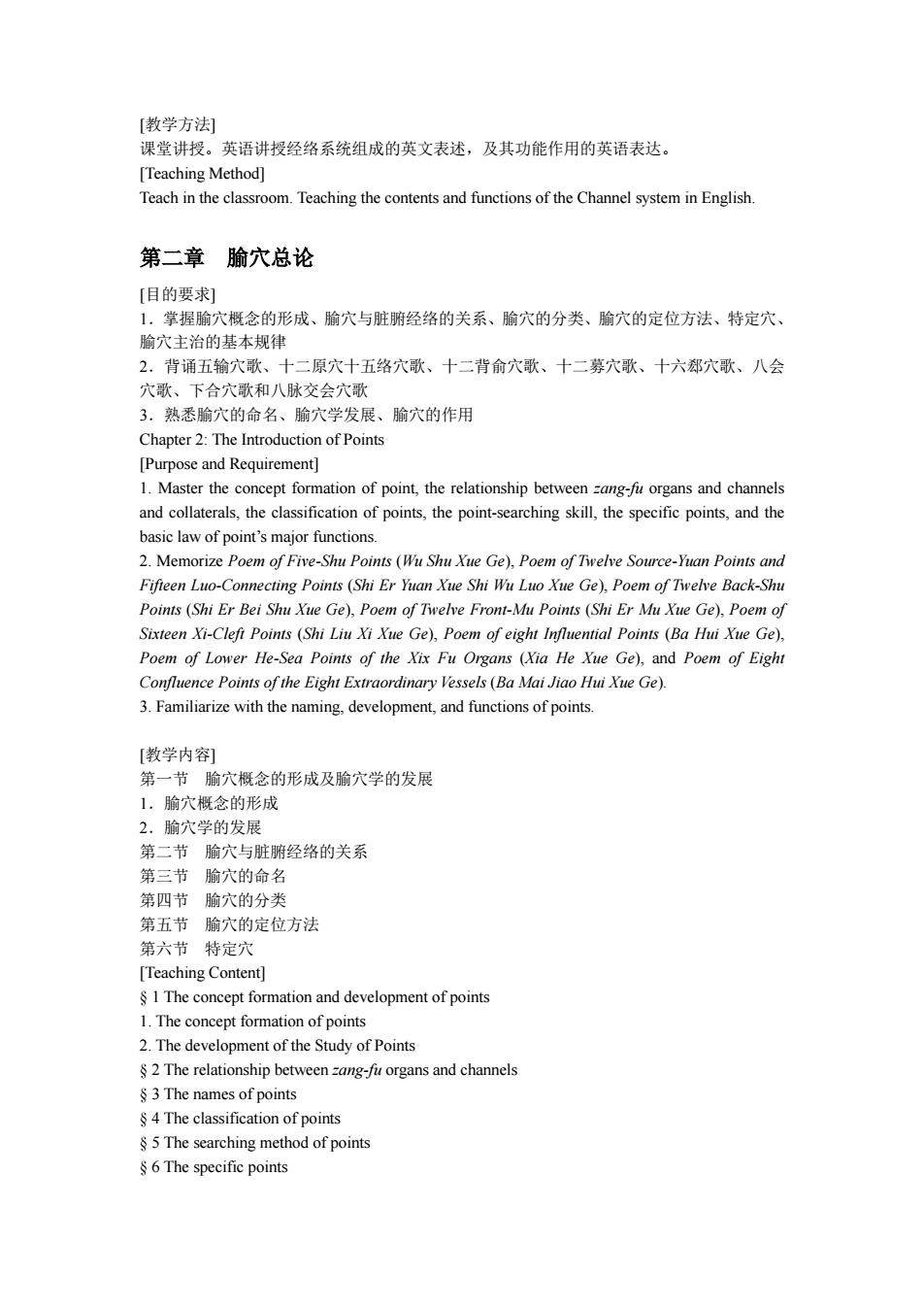正在加载图片...

[教学方法] 课堂讲授。英语讲授经络系统组成的英文表述,及其功能作用的英语表达。 [Teaching Method] Teach in the classroom.Teaching the contents and functions of the Channel system in English 第二章 腧穴总论 [目的要求] 1.掌握腧穴概念的形成、腧穴与脏腑经络的关系、腧穴的分类、腧穴的定位方法、特定穴、 腧穴主治的基本规律 2.背诵五输穴歌、十二原穴十五络穴歌、十二背俞穴歌、十二募穴歌、十六郄穴歌、八会 穴歌、下合穴歌和八脉交会穴歌 3.熟悉腧穴的命名、腧穴学发展、腧穴的作用 Chapter 2:The Introduction of Points [Purpose and Requirement] 1.Master the concept formation of point,the relationship between zang fit organs and channels and collaterals,the classification of points,the point-searching skill,the specific points,and the basic law of point's major functions. 2.Memorize Poem of Five-Shu Points(Wu Shu Xue Ge),Poem of Twelve Source-Yuan Points and Fifteen Luo-Connecting Points(Shi Er Yuan Xue Shi Wu Luo Xue Ge),Poem of Twelve Back-Shu Points (Shi Er Bei Shu Xue Ge),Poem of Twelve Front-Mu Points (Shi Er Mu Xue Ge),Poem of Sixteen Xi-Cleft Points(Shi Liu Xi Xue Ge),Poem of eight Influential Points(Ba Hui Xue Ge), Poem of Lower He-Sea Points of the Xix Fu Organs (Xia He Xue Ge),and Poem of Eight Confluence Points of the Eight Extraordinary Vessels(Ba Mai Jiao Hui Xue Ge). 3.Familiarize with the naming,development,and functions of points. [教学内容] 第一节腧穴概念的形成及腧穴学的发展 1.腧穴概念的形成 2.腧穴学的发展 第二节腧穴与脏腑经络的关系 第三节腧穴的命名 第四节腧穴的分类 第五节腧穴的定位方法 第六节特定穴 [Teaching Content] 1 The concept formation and development of points 1.The concept formation of points 2.The development of the Study of Points $2 The relationship between zang-fit organs and channels §3 The names of points $4 The classification of points $5 The searching method of points §6 The specific points[教学方法] 课堂讲授。英语讲授经络系统组成的英文表述,及其功能作用的英语表达。 [Teaching Method] Teach in the classroom. Teaching the contents and functions of the Channel system in English. 第二章 腧穴总论 [目的要求] 1.掌握腧穴概念的形成、腧穴与脏腑经络的关系、腧穴的分类、腧穴的定位方法、特定穴、 腧穴主治的基本规律 2.背诵五输穴歌、十二原穴十五络穴歌、十二背俞穴歌、十二募穴歌、十六郄穴歌、八会 穴歌、下合穴歌和八脉交会穴歌 3.熟悉腧穴的命名、腧穴学发展、腧穴的作用 Chapter 2: The Introduction of Points [Purpose and Requirement] 1. Master the concept formation of point, the relationship between zang-fu organs and channels and collaterals, the classification of points, the point-searching skill, the specific points, and the basic law of point’s major functions. 2. Memorize Poem of Five-Shu Points (Wu Shu Xue Ge), Poem of Twelve Source-Yuan Points and Fifteen Luo-Connecting Points (Shi Er Yuan Xue Shi Wu Luo Xue Ge), Poem of Twelve Back-Shu Points (Shi Er Bei Shu Xue Ge), Poem of Twelve Front-Mu Points (Shi Er Mu Xue Ge), Poem of Sixteen Xi-Cleft Points (Shi Liu Xi Xue Ge), Poem of eight Influential Points (Ba Hui Xue Ge), Poem of Lower He-Sea Points of the Xix Fu Organs (Xia He Xue Ge), and Poem of Eight Confluence Points of the Eight Extraordinary Vessels (Ba Mai Jiao Hui Xue Ge). 3. Familiarize with the naming, development, and functions of points. [教学内容] 第一节 腧穴概念的形成及腧穴学的发展 1.腧穴概念的形成 2.腧穴学的发展 第二节 腧穴与脏腑经络的关系 第三节 腧穴的命名 第四节 腧穴的分类 第五节 腧穴的定位方法 第六节 特定穴 [Teaching Content] § 1 The concept formation and development of points 1. The concept formation of points 2. The development of the Study of Points § 2 The relationship between zang-fu organs and channels § 3 The names of points § 4 The classification of points § 5 The searching method of points § 6 The specific points